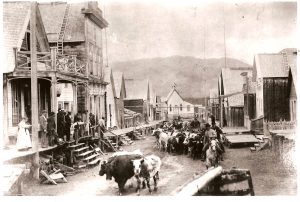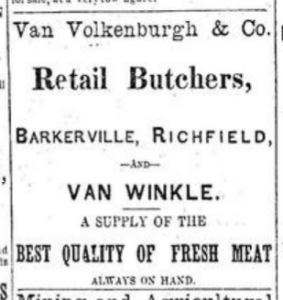Butchers of Barkerville
The trail through the Okanagan Valley was a major transportation route during the gold rush years of 1858 to 1868. Cattle drovers found a ready market for their beef at the various towns and stopping houses along the trail to the Cariboo. In the early years, towns like Lytton, Clinton and Quesnel, had butcher shops where the beef could be sold. By 1862, Williams Creek had become the heart of the Cariboo gold fields and the booming new towns of Barkerville and Richfield were the supply centres for the surrounding creeks. One of the first butchers to appear on Williams Creek was Francois Casse, who opened a butcher shop in Richfield. He was followed by Patrick Gannon and Romi Dizette, who also opened a shop in Richfield and the partnership of Dominic Ercole and Joseph Chassot in Barkerville.
Charles M. Beak drove 300 cattle from Oregon to the Cariboo in 1862, selling some of them along the way. Returning to Oregon the following year, he partnered with James Doyle and drove a large flock of sheep all the way to Barkerville, where they sold mutton at forty cents a pound and made candles from the mutton tallow, which sold for fifty cents a pound. Competition in the sale of meat became fierce and, in 1866, Doyle and Beak dissolved their partnership. Beak returned to Oregon and married. When he made his return trip with his new bride to the Cariboo, he drove 200 head of cattle, the sale of which allowed him to purchase the 108 Mile House. Banding together with other ranchers, Beak established the “Cariboo Market” in Barkerville and Richfield in 1868.
The problem that confronted the Cariboo butchers was maintaining a steady supply of cattle and sheep for slaughter. The Cariboo Sentinel of May 10, 1866 reported, “There is not a pound of beef or mutton to be procured at any of the butchering establishments on the creek. At Richfield we believe there is a small quantity of fresh pork which sells readily at 62 cents per lb. Mr. Toomey and Mr. Clark are both out after cattle, and are expected back in a few days; until then we will have to betake ourselves of the old fare of earlier times, beans and bacon, for a change.”[1]
In 1867, Patrick Gannon, having dissolved his partnership with Romi Dizette the previous year, formed a new company and constructed a slaughter house on the hill between Barkerville and Richfield. Not to be outdone, the Van Volkenburgh brothers, Benjamin, Abraham and Isaac, built a second slaughterhouse in the same area on what came to be called Cow Mountain. The Van Volkenburghs formed a partnership with Jerome and Thaddeus Harper, who annually drove cattle up from California and Oregon. The Harpers used the 150 Mile House as a staging area to hold the cattle before driving them a few at a time to Barkerville. The ranch which was owned by Edward Tormey, a butcher from San Francisco who also owned butcher shops in Barkerville, Quesnelle Forks and Quesnelle Mouth (today’s Quesnel). The six men, the Van Volkenburghs, the Harpers and Tormey formed a company, Van Volkenburgh & Co. The partners made sure their slaughter house was state of the art. A visitor in 1868 noted, “We paid a visit this week to the abattoir of Messrs. Van Volkenburgh & Co., with their extensive contiguous warehouse, built and fitted up expressly for storing fresh meat for winter use. Messrs. Van Volkenburgh & Co. have been killing off stock for winter for the past few weeks, the last lot of which, consisting of over 30 head, were just brought in by Messrs. Harper & Tormey.”[2]
Van Volkenburgh & Co.’s grip on the market grew stronger, thanks to the Harpers’ steady supply of a variety of animals. In 1869, it was reported, “Mr. Jerome Harper is about to furnish Cariboo with an abundant supply of spring lamb meat. We may expect to enjoy the delicacy in two or three weeks. Last fall Mr. Harper put 2800 sheep to winter and they now number 4,000. Of this number 1200 are lambs, all dropped early this spring. One flock was out all winter at Lillooet and another at Big Bar. Out of the entire 4000 only 15 have been lost. There were 1100 ewes altogether in both flocks. Mr. Harper’s enterprise in sheep-raising has been a success, and we trust will prove as profitable to himself as it is beneficial to the country.”[3] Later it was reported that “Van Volkenburgh & Co. have received a supply of splendid hams and bacons cured at the Clinton Mills [owned] by Harper Bros. The hogs were fed on grain and middlings and averaged in weight from 500 to 800 lbs. Harper Bros. will have 100,000 lbs. of the finest bacon and hams for the Cariboo and Omineca markets cured at their own mills.”[4]
As the years went by and the population of the towns on Williams Creek dwindled, the market was easily supplied by Van Volkenburgh & Co. The partnership began to lose members. In 1871 it was announced Edward Tormey had died in California. The Cariboo Sentinel lamented his passing. “Mr. Tormey was one of the first settlers in this district and amassed a considerable fortune in early days, since which time he has been extensively engaged in the butchering and cattle-raising business, and for some years owned the 150-mile House and ranch. He had gone for a short visit to California when he was so suddenly cut off.”[5] In 1874, Jerome Harper passed away, also in California. After the death of his brother, Thaddeus Harper sold his interest in the company but continued to raise cattle, in the 1880s founding the famous Gang Ranch in the Chilcotin.
The Van Volkenburgh brothers carried on the business, opening butcher shops in every large town and city in British Columbia. In the early 1880s, they partnered with other well-to-do British Columbians, including Charles M. Beak, to establish the Douglas Lake Cattle Company to supply beef to the railway crews in the province.
[1] Cariboo Sentinel, May 10, 1866.
2 Richard Wright, Barkerville, p. 39.
[3] Cariboo Sentinel, June 12, 1869.
[4] Cariboo Sentinel, March 9, 1872.
[5] Cariboo Sentinel, May 29, 1871.



